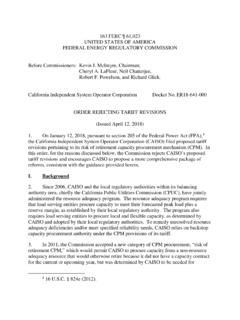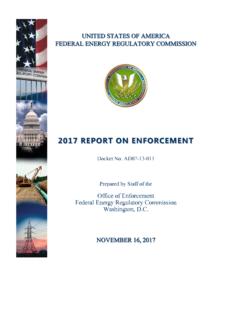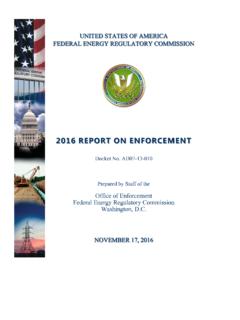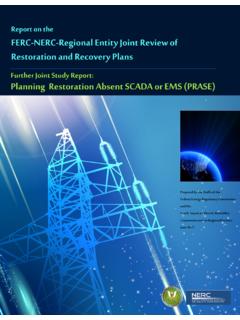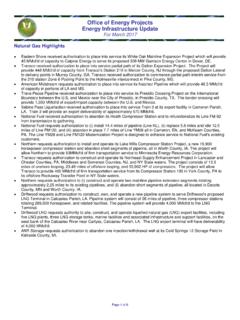Transcription of Security Plan Example - Federal Energy Regulatory …
1 Example Security Plan Section 1 PURPOSE: This Security Plan constitutes the "Standard Operating Procedures" relating to physical, cyber, and procedural Security for all (Utility) hydro projects. It contains a comprehensive overview of the (Utility)'s Security program, and in some sections, makes reference to other relevant plans and procedures. Security personnel, operators, and selected hydro personnel shall be familiar with the information and procedures associated with this Security Plan. Distribution: A copy of this plan shall reside in each of the following locations: > Headquarters Security Operations Center > Hydro Project Control Rooms > Systems Operations Center > Emergency Action Plan Manager > Plant Managers > General Counsel (Legal) > Chief Risk Officer Revision Date: April 29, 2010 Section 2 SITE MAPS: These site maps reveal the restricted areas of each hydro project, as well as the physical Security layouts that protect such areas.
2 The measures listed below are incorporated into the Security layouts, and shall be utilized to control and enforce access to the restricted areas: Guard posts (with barriers and "Tiger Teeth") - located at each access point Placement of fencing, locked gates, barricades, and signage Placement of signage and buoy lines - upstream and downstream of dam Electronic Access - Identification/access badges issued to employees and approved contractors. Doors and barrier arms can be activated by: 1) employee displaying access badge, or 2) operated by on-site guard, or 3) operated remotely from Security Operations Center.
3 "Hydro Access Request" - screening process for contractors and visitors Security camera monitoring - 1) Security staff ( Security Operations Center), 2) control room operators, 3) Systems Operations Center personnel, 4) Regional dispatch center for law enforcement and fire services, and 5) the State Patrol. Intrusion alarm monitoring - 1) Alarm central (contracted monitoring agency), 2) Security staff ( Security Operations Center) Contracted guards -- inspection patrols Law enforcement - observation patrols Section 3 HYDRO PROJECT Critical Physical Dam Related Assets External access Physical Security Detection Delay Response Response Time Assessment (external) Assessment (internal) Security Assessment Security Plan Cyber Security Dam (Structure)
4 Spill Gates/Controls Intake Units Transformers Powerhouse Generator Floor Control Room Switchyard Transmission Abutments Fishway Structure Penetrations Irrigation Structure Penetrations Recreation Structure Penetration Visitor Center Maintenance Galleries Domestic Water HazMat storage CPME CDP&R Section 4 Security SYSTEMS: The (Utility) utilizes a number of Security systems designed to help fulfill its Security mission.
5 These systems complement the policies, procedures, and measures that form the (Utility)'s robust Security program. The (Utility)'s Security systems include: 1. Fencing & Gates Fencing is the first layer of Security at all of our Hydro projects, Transmission/Distribution points, and (Utility) facilities. The (Utility) has standardized on 8-foot fencing, using tension wire in lieu of bars, placing fence barbs up, and securing the bottom of the fencing below grade. Access points/gates are secured through one of the following methods: Manually opened and secured with a heavy duty (Utility) approved pad lock, electronically accessed with card credential, or electronically accessed with remote gate fob.
6 All perimeters and access points are monitored 24/7 by CCTV or contracted Security guards. 2. Exterior Lighting Exterior lighting has been strategically placed throughout the (Utility) to emphasize and highlight perimeters, gate and Guard Post access points, entry points into buildings, and areas of interest. Lighting can be activated by motion or photo-cell. Exterior lighting serves as a deterrent, as well as to aid in monitoring of the (Utility)'s CCTV system. 3. CCTV The (Utility) has deployed over 100 CCTV cameras throughout the county. These cameras have Pan/Tilt/Zoom (PTZ) capabilities, and are strategically placed throughout the projects.
7 Via our unique Fiber Optic infrastructure, these camera signals are sent back centrally to the (Utility)'s headquarters office where they are recorded 24/7. From this central point, Security has the ability to monitor and control all cameras. In addition, Security shares control and monitoring of these cameras with the Hydro projects, System Operations (Dispatch), Engineering staff, as well as three local law enforcement agencies and Regional Dispatch Center. This CCTV system is monitored 24/7. 4. Electronic Access Control The (Utility) utilizes a comprehensive Electronic Access Control system, which has been installed throughout the projects and facilities.
8 These card access points secure doors to buildings, access gates, and barrier arms. Through this technology, Security is able to effectively track and control access. Each employee and contractor is required to wear an identification/access badge which is individually tailored for specific access. The (Utility) has also installed a CIP-specific Electronic Access Control system which ensures restricted access to Critical Cyber Asset areas. These Electronic Access Control systems are monitored 24/7. 5. Intrusion alarms Intrusion alarms are utilized throughout the (Utility). These alarms serve two important functions: Provide 24/7 monitoring in remote locations where staff is not always present.
9 Installed in all CIP-designated spaces. The alarm sensors include door/window contacts, motion detection, and glass break. These Intrusion alarm systems are monitored 24/7. 6. Security Guards The (Utility) contracts the services of a private Security company. Guards are stationed at the Hydro Projects. Additionally, "patrol" guards are assigned to conduct Security checks of the (Utility)'s properties -- including the hydro projects. 7. Law Enforcement Support The (Utility) has developed strong partnerships with the local law enforcement agencies. These agencies support the (Utility)'s Security mission through collaborative training & exercises, observation patrols, response to incidents, and proactive meetings.
10 (UTILITY) Closed Circuit Television (CCTV) CCTV cameras, controls and monitoring have been upgraded and expanded to increase critical infrastructure protection and to: Provide enhanced Security and safety at (Utility) facilities; Provide operational viewing of (Utility) projects; Provide safety alerts or response to a major event. Provide emergency responders with video coverage (where available) of critical incidents. Use of (Utility) CCTV is appropriate for Security , safety, operational and/or emergency responses. Use of (Utility) CCTV is not appropriate for monitoring or assessing employee productivity.
